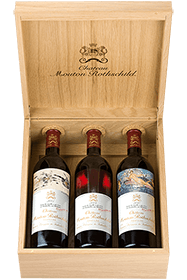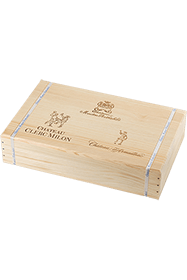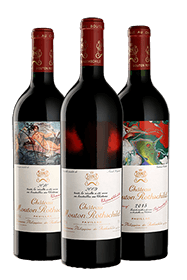Location and surface area of the Château Mouton Rothschild vineyard
Château Mouton Rothschild is located in the northern part of the Pauillac appellation, in the Médoc region. The estate reigns over a 90-hectare vineyard and enjoys an exceptional terroir, located between the Gironde estuary to the east and the Atlantic Ocean to the west.
An iconic reference among fine Pauillac wines, the name of this estate is synonymous with power and prestige and produces fine Left-Bank wines. Château Mouton Rothschild is the youngest of the Five First Classified Growths of Bordeaux.
What is the history of Château Mouton Rothschild?
Origins that hark back to 1853
From the English side of the prosperous Rothschild family, Nathaniel de Rothschild acquired Château Brane-Mouton at an auction in 1853. This property was renowned in the 18th and 19th centuries for the quality of its wines, then produced under the direction of the Marquis Nicolas-Alexandre de Ségur and the Barons of Brane. As soon as he arrived, Baron Nathaniel de Rothschild renamed the property Château Mouton Rothschild and embarked on a long restructuring process on the vineyard, which had been neglected in the decade before the sale.
1922, the beginning of the Philippe de Rothschild era
The great-grandson of Baron Nathaniel de Rothschild, Baron Philippe de Rothschild took over the running of the estate in 1922.
With his strong personality and great determination, Baron Philippe de Rothschild remained at the helm of the estate for 65 years. He is still regarded as the "soul" of Château Mouton Rothschild today, and is the source of its current success and worldwide reputation.
A visionary man, he did not hesitate for long to make key decisions that would revolutionise both the estate and the world of Bordeaux wine in general. In 1924, he decided that all Château Mouton Rothschild wines should be bottled on the estate rather than sold in barrels to Bordeaux merchants. This choice was decisive for the development and reputation of the estate's wines beyond French borders.
Entwining with the world of art
Designed by the architect Charles Siclis, the emblematic 100-metre-long Grand Chai of Château Mouton Rothschild was unveiled in 1926. Around the same time, Baron Philippe de Rothschild asked the artist Jean Carlu to design a poster announcing the bottling of wine at the estate. He chose a cubist illustration of the château's "mascot", the ram. This first foray into the world of art gave rise to new and rich tradition; a collaboration between art and wine at Château Mouton Rothschild.
Significant growth from the 1930s
After launching Mouton Cadet in 1930, which quickly became an international success, Baron Philippe acquired a wine trading company based in Pauillac, which became Baron Philippe de Rothschild SA. The visionary Rothschild family developed its activities through the acquisition of Château Mouton d'Armailhacq (now known as Château d'Armailhac) in 1933 and Château Clerc Milon in 1970.
Difficult times during the Second World War
During the Second World War, Baron Philippe de Rothschild was detained and stripped of his French nationality. He fled to England and joined Charles de Gaulle in the Free French Forces. His wife, Elisabeth Pelletier de Chambure, was arrested by Nazi forces and died in a concentration camp in 1945.
The birth of an emblematic tradition with the 1945 vintage
Upon his return to France at the end of the Second World War, Baron Philippe de Rothschild was inspired by the spirit of the Allied victory and commissioned a young, unknown artist by the name of Philippe Jullian to design a label for the 1945 vintage, commemorating the "year of victory" and the return of peace to France.
Among the many projects submitted by Philippe Jullian, the label selected was one whose design was based on Winston Churchill's famous "V for Victory" speech.
Since then, each new vintage of Château Mouton Rothschild's Grand Vin has been adorned with a label designed by a famous artist, such as Picasso, Chagall, Miro or Dali. In 1962, a Museum of Wine in Art was created within the estate, containing a collection of precious objects related to wine and art.
The youngest of the Five First Classified Growths of Bordeaux
Following the war, the Baron undertook one of the greatest projects of his life.
In the famous 1855 Bordeaux Wine Classification, Mouton Rothschild was classified as a Second Growth in Pauillac, even though the estate's wines were widely recognised as being of the same quality as those of the four First Growth châteaux: Margaux, Lafite, Latour and Haut-Brion.
After nearly twenty years of tireless efforts, Baron Philippe de Rothschild triumphed in 1973, when Jacques Chirac (then Minister of Agriculture) signed an official decree declaring Château Mouton Rothschild the fifth Premier Cru Classé of Pauillac.
From then on, the estate's motto, formerly "First do not know, second do not know, Mouton is", was officially changed to "First, I am. Second, I used to be. Mouton does not change.’’
A passion for wine also turned towards the New World
A visionary and passionate man, Baron Philippe de Rothschild was eager to extend his Bordeaux wine-making expertise to the New World. Thus, in the late 1970s, he formed a partnership with the famous American winemaker Robert Mondavi, leading to the creation of the legendary Opus One, which quickly became an iconic standard among great Californian wines.
A forward-looking estate
Following the death of Baron Philippe de Rothschild in 1988, his only daughter Baroness Philippine de Rothschild took over the running of Château Mouton Rothschild
Fully assuming the great responsibility that comes with this exceptional heritage, Baroness Philippine de Rothschild ended her brilliant career as an actress at the Comédie Française to devote herself to the family business.
Following in her father's footsteps, Baroness Philippine de Rothschild set up an array of projects to continue to boast and develop the estate's international soul. Such is the case, for example, with the creation in 1981 of a travelling exhibition entitled "Mouton Rothschild - Paintings for Labels", which has been exhibited in over 40 museums around the world.
The same applies to the estate's wines. In 1991, for example, the first vintage of Aile d'Argent was released, a high-quality white wine produced from around 8 hectares of vines planted in the 1980s. Then, in 1993, the first vintage of Petit Mouton de Château Mouton Rothschild, the estate's second wine, was unveiled.
Continuing her father's interest in wines from beyond Bordeaux, Baroness Philippine de Rothschild instigated a renovation of the Opus One cellars in 1991. An innovative partnership was also established with winemaker Don Melchor de Concha y Toro in 1997, giving rise to the iconic Chilean wine, Almaviva. Lastly, the Domaine de Baronarques was created in 2003, producing red and white wines from the Pays d'Oc.
An illustrious figure in the history of Château Mouton Rothschild and the Bordeaux wine community, Baroness Philippine de Rothschild died in 2014. Since then, her children, Philippe Sereys de Rothschild, Camille Ogren and Julien de Beaumarchais have worked closely together to continue to elevate Château Mouton Rothschild and its wines to ever higher levels of excellence.
All there is to know about the terroir of Château Mouton Rothschild
Location and exposure
The Château Mouton Rothschild vineyard covers 90 hectares within the Pauillac appellation. The vines are planted on a terroir whose rugged land is made up of a series of "croups" culminating at an altitude of 27 metres. The names of certain Médoc properties refer to these terroirs where the finest plots have historically been planted. The name of Château Mouton Rothschild is therefore not linked to the animal, but rather to the meaning of the Old French word "mothon", meaning a mound.
Geology: a rare mosaic that favours the development of the vines
The vines of Château Mouton Rothschild are planted on very deep gravel soils, also composed of sand, clay and limestone. The pebbles and cobbles that form the base of this topsoil have the advantage of retaining the heat of the sun which enables the fruit to ripen gradually. This is the ideal terroir for Cabernet Sauvignon, which was first planted in the region in the 19th century.
Climate: a vineyard with a temperate oceanic climate
Due to its geographical position near the estuary, the Pauillac appellation benefits from a temperate oceanic climate, characterised by mild, wet winters and relatively cool summers.
Growing practices
True to the motto "First, I am. Second, I used to be. Mouton does not change.", the production of Château Mouton Rothschild wines is entrusted to the care of a small team of experts who are the best in their field.
From the ploughing of the vines to bottling, each stage is carried out by these craftsmen whose know-how is often passed down from generation to generation. It is this heritage, so deeply engraved in the identity of Mouton Rothschild, that leads to the production of the most famous wines across borders year after year, exuding the nuances and identity of the region's typical grape varieties, namely Cabernet Sauvignon, Merlot and Cabernet Franc.
Vinification
The grapes are harvested by hand in small crates to preserve their integrity, and are then destemmed before a rigorous manual sorting of the berries on vibrating tables is carried out. Only the best fruit is selected and transferred to tanks, then to fermentation vats using a 100% gravity-fed process. Inaugurated in 2012, the cutting edge vat room at Château Mouton Rothschild is at the height of technology. On two levels, this high-tech wood and steel gravity-fed space houses 44 oak vats, enabling highly precise parcel-based fermentations to be carried out. The vat room also houses 20 stainless steel vats. After vinification, the wines are aged exclusively in new oak barrels, in line with the Médoc region’s traditions, with regular topping up of the barrels and fining with egg white before bottling. The wine is aged in the estate's emblematic Grand Chai for 20 to 22 months, during which time the barrels are moved from the Grand Chai to the estate's second cellars for the second year of ageing until the end of the ageing process.
The style of the wines of Château Mouton Rothschild
Wine profile
The Grand Vin of Château Mouton Rothschild seduces with its refined character and its delicate alliance between power and aromatic richness. Its complex nose blends black fruit fragrances with savoury notes of spices, tobacco, graphite and fresh cedar. Throughout the tasting, Château Mouton Rothschild reveals a smooth texture and fine tannins that stretch to a persistent and subtly mineral finish.
Produced since 1993, Le Petit Mouton de Mouton Rothschild is the estate's second wine, made from younger vines than its elder, the Grand Vin. Vinified with the same rigour as the Grand Vin, this cuvée is the perfect expression of the elegance and richness of the great Pauillac terroirs.
The Petit Mouton de Mouton Rothschild is adorned with a label inspired by a work of art created in 1927 by the painter and poster artist Jean Carlu, who designed the label for Château Mouton Rothschild 1924. The initial name of the wine when it was released in 1993 was "Le Second Vin de Mouton Rothschild", but this was changed in 1994 to "Le Petit Mouton de Mouton Rothschild" in reference to the residence of Baroness Philippine located at the heart of the estate.
In a constant quest for innovation, Philippine de Rothschild revived an old Médoc tradition in the early 1980s by deciding to plant a few hectares of vines with white grape varieties. Thus was born Aile d'Argent, the estate's white wine, made from a blend of Sauvignon Blanc, Semillon, Sauvignon Gris and Muscadelle. Aged 50% in new oak barrels, this white wine, produced in very small quantities, seduces with its richness and elegance. The name of this cuvée refers to a tale that Baron Philippe de Rothschild wrote in prison for his daughter Philippine, called "Aile d'Argent la Magique" published in 1947 by Gallimard.
Ageing potential of the estate’s wines
Due to their complexity, finesse and refinement, the wines of Château Mouton Rothschild can be kept in the cellar for many years, in order to reveal all their finesse and aromatic potential.




























